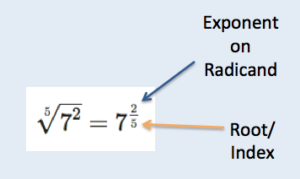Radical Expressions and Rational Exponents
Learning Outcomes
- Convert between radical and exponent notations
|
Radical Form |
Exponent Form |
Principal Root |
|---|---|---|
| [latex] \sqrt{16}[/latex] | [latex] {{16}^{\tfrac{1}{2}}}[/latex] | [latex]4[/latex] |
| [latex] \sqrt{25}[/latex] | [latex] {{25}^{\tfrac{1}{2}}}[/latex] | [latex]5[/latex] |
| [latex] \sqrt{100}[/latex] | [latex] {{100}^{\tfrac{1}{2}}}[/latex] | [latex]10[/latex] |
Example
Fill in the missing cells in the table.| Exponent Form | Root Form | Root of a Square | Simplified |
|---|---|---|---|
| [latex] {{36}^{\frac{1}{2}}}[/latex] | |||
| [latex]\sqrt{81}[/latex] | |||
| [latex] \sqrt{{{12}^{2}}}[/latex] |
Answer:
| Exponent Form | Root Form | Root of a Square | Simplified |
|---|---|---|---|
| [latex] {{36}^{\frac{1}{2}}}[/latex] | [latex] \sqrt{36}[/latex] | [latex] \sqrt{{{6}^{2}}}[/latex] | [latex]6[/latex] |
| [latex] {{81}^{\frac{1}{2}}}[/latex] | [latex] \sqrt{81}[/latex] | [latex] \sqrt{{{9}^{2}}}[/latex] | [latex]9[/latex] |
| [latex] {{144}^{\frac{1}{2}}}[/latex] | [latex] \sqrt{144}[/latex] | [latex]\sqrt{{{12}^{2}}}[/latex] | [latex]12[/latex] |
|
Radical Form |
Exponent Form |
Principal Root |
|---|---|---|
| [latex] \sqrt[3]{8}[/latex] | [latex] {{8}^{\tfrac{1}{3}}}[/latex] | [latex]2[/latex] |
| [latex] \sqrt[3]{125}[/latex] | [latex] {{125}^{\tfrac{1}{3}}}[/latex] | [latex]5[/latex] |
| [latex] \sqrt[3]{1000}[/latex] | [latex] {{1000}^{\tfrac{1}{3}}}[/latex] | [latex]10[/latex] |
|
Radical Form |
Exponent Form |
|---|---|
| [latex] \sqrt{x}[/latex] | [latex] {{x}^{\tfrac{1}{2}}}[/latex] |
| [latex] \sqrt[3]{x}[/latex] | [latex] {{x}^{\tfrac{1}{3}}}[/latex] |
| [latex] \sqrt[4]{x}[/latex] | [latex] {{x}^{\tfrac{1}{4}}}[/latex] |
| … | … |
| [latex] \sqrt[n]{x}[/latex] | [latex] {{x}^{\tfrac{1}{n}}}[/latex] |
Example
Write [latex] \sqrt[4]{81}[/latex] as an expression with a rational exponent.Answer: The radical form [latex]\sqrt[4]{{a}}[/latex] can be rewritten as the exponent [latex]a^{\frac{1}{4}}[/latex]. Remove the radical and place the exponent next to the base.
[latex]\sqrt[4]{{81}}=81^{\frac{1}{4}}[/latex]
Writing Fractional Exponents
Any radical in the form [latex]\sqrt[n]{a}[/latex] can be written using a fractional exponent in the form [latex]a^{\frac{1}{n}}[/latex].Write an Expression with a Rational Exponent as a Radical
In the following examples, we will show how to convert expressions with rational exponents to expressions with a radical.Example
Express [latex] {{(2x)}^{^{\frac{1}{3}}}}[/latex] in radical form.Answer: Rewrite the expression with the fractional exponent as a radical. The denominator of the fraction determines the root, in this case the cube root.
[latex]\sqrt[3]{2x} [/latex]
The parentheses in [latex] {{\left( 2x \right)}^{\frac{1}{3}}}[/latex] indicate that the exponent refers to everything within the parentheses.Example
Express [latex] 2{{x}^{^{\frac{1}{3}}}}[/latex] in radical form.Answer: Rewrite the expression with the fractional exponent as a radical. The denominator of the fraction determines the root, in this case the cube root.
[latex] 2\sqrt[3]{x}[/latex]
The exponent refers only to the part of the expression immediately to the left of the exponent, in this case x, but not the [latex]2[/latex].Write an Expression with a Radical as a Rational Exponent
 Flexibility
FlexibilityExample
Express [latex] 4\sqrt[3]{xy}[/latex] with rational exponents.Answer: Rewrite the radical using a rational exponent. The root determines the fraction. In this case, the index of the radical is [latex]3[/latex], so the rational exponent will be [latex] \frac{1}{3}[/latex].
[latex] 4{{(xy)}^{\frac{1}{3}}}[/latex]
Since [latex]4[/latex] is outside the radical, it is not included in the grouping symbol and the exponent does not refer to it.Rational Exponents Whose Numerator is Not Equal to One
Notice that in the previous two examples, the radicands had exponents. We simplified these expressions using factorsing, but we can still convert these radical expressions to expressions with rational exponents. Also, note that all of the numerators for the fractional exponents in the previous examples above were [latex]1[/latex]. You can use fractional exponents that have numerators other than [latex]1[/latex] to express roots, as shown below.|
Radical |
Exponent |
|---|---|
| [latex] \sqrt{9}[/latex] | [latex]9^{\frac{1}{2}}[/latex] |
| [latex] \sqrt[3]{{{9}^{2}}}[/latex] | [latex]9^{\frac{2}{3}}[/latex] |
| [latex]\sqrt[4]{9^{3}}[/latex] | [latex]9^{\frac{3}{4}}[/latex] |
| [latex]\sqrt[5]{9^{2}}[/latex] | [latex]9^{\frac{2}{5}}[/latex] |
| … | … |
| [latex]\sqrt[n]{9^{x}}[/latex] | [latex]9^{\frac{x}{n}}[/latex] |
 To rewrite a radical using a fractional exponent, the power to which the radicand is raised becomes the numerator and the root/index becomes the denominator.
To rewrite a radical using a fractional exponent, the power to which the radicand is raised becomes the numerator and the root/index becomes the denominator.
Writing Rational Exponents
Any radical in the form [latex]\sqrt[n]{a^{x}}[/latex] can be written using a fractional exponent in the form [latex]a^{\frac{x}{n}}[/latex].Example
Rewrite the radicals using a rational exponent, then simplify your result.- [latex]\sqrt[3]{{{a}^{6}}}[/latex]
- [latex]\sqrt[12]{16^3}[/latex]
Answer: 1.[latex]\sqrt[n]{a^{x}}[/latex] can be rewritten as [latex]a^{\frac{x}{n}}[/latex], so in this case [latex]n=3,\text{ and }x=6[/latex], therefore [latex-display]\sqrt[3]{{{a}^{6}}}={{a}^{\frac{6}{3}}}[/latex-display] Simplify the exponent. [latex-display]{{a}^{\frac{6}{3}}}={{a}^{2}}[/latex-display] 2. [latex]\sqrt[n]{a^{x}}[/latex] can be rewritten as [latex]a^{\frac{x}{n}}[/latex], so in this case [latex]n=12,\text{ and }x=3[/latex], therefore
[latex]\sqrt[12]{16^3}={16}^{\frac{3}{12}}={16}^{\frac{1}{4}}[/latex]
Simplify the expression using rules for exponents. [latex-display]{16}^{\frac{1}{4}}=2[/latex-display]Try It
[ohm_question]3537[/ohm_question]Example
Rewrite the expressions using a radical.- [latex]{x}^{\frac{2}{3}}[/latex]
- [latex]{5}^{\frac{4}{7}}[/latex]
Answer:
- [latex]{x}^{\frac{2}{3}}[/latex], the numerator is [latex]2[/latex] and the denominator is [latex]3[/latex], therefore we will have the third root of x squared, [latex]\sqrt[3]{x^2}[/latex]
- [latex]{5}^{\frac{4}{7}}[/latex], the numerator is [latex]4[/latex] and the denominator is [latex]7[/latex], so we will have the seventh root of [latex]5[/latex] raised to the fourth power. [latex]\sqrt[7]{5^4}[/latex]
Summary
Any radical in the form [latex]\sqrt[n]{a^{x}}[/latex] can be written using a fractional exponent in the form [latex]a^{\frac{x}{n}}[/latex]. Rewriting radicals using fractional exponents can be useful when simplifying some radical expressions. When working with fractional exponents, remember that fractional exponents are subject to all of the same rules as other exponents when they appear in algebraic expressions.Contribute!
Licenses & Attributions
CC licensed content, Original
- Write Expressions Using Radicals and Rational Exponents. Authored by: James Sousa (Mathispower4u.com) for Lumen Learning. License: CC BY: Attribution.
- Revision and Adaptation. Provided by: Lumen Learning License: CC BY: Attribution.
CC licensed content, Shared previously
- Unit 16: Radical Expressions and Quadratic Equations, from Developmental Math: An Open Program. Provided by: Monterey Institute of Technology Located at: https://www.nroc.org/. License: CC BY: Attribution.
- Precalculus. Provided by: OpenStax Authored by: Abramson, Jay. Located at: https://cnx.org/contents/[email protected]:1/Preface. License: Public Domain: No Known Copyright. License terms: Dwonload fro free at : http://cnx.org/contents/[email protected]:1/Preface.
